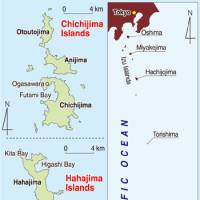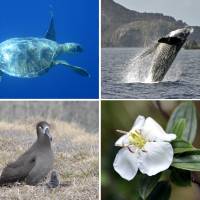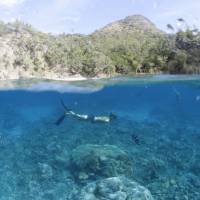The Ogasawaras are a group of lovely subtropical islands about 1,000 km due south of Tokyo, from where they are administered. As there is no airport, you reach them by taking the 6,700-ton liner Ogasawara Maru from Takeshiba Pier in Tokyo — a 25-hour journey that can be rough, so take one of the better cabins if you can afford it.
In July of this year, the Ogasawara Islands became a World Heritage Site — in other words, they were designated by the World Heritage Committee as being of special cultural or physical significance. That body was founded through the "Convention Concerning the Protection of the World Cultural and Natural Heritage," which was adopted by the General Conference of the United Nations Educational, Scientific and Cultural Organisation (UNESCO) in Paris on Nov. 16, 1972. The World Heritage Convention, as it is also officially known, has to date been ratified by 186 states worldwide.
In the late 1960s, I was the first Game Warden of the Simien Mountain National Park in Ethiopia. This 220-sq.-km area, with its rare animals, birds and plants, and its magnificent cliffs, some 1,500 meters high, was granted UNESCO World Heritage status in 1978.
Japan was very late in joining this program, and I was a member of a committee that urged its joining, and which nominated Yakushima Island south of Kyushu in Kagoshima Prefecture to be put forward for consideration as a World Heritage Site.
It took an awful lot of pleading and arguing, because it was very clear that certain sections of the Japanese government were adamantly opposed to any outside interference in what they wanted to do. For instance, the Forestry Agency rewarded itself well through cutting down ancient Japanese cedar (or cryptomeria) trees.
On Yakushima, where the most ancient of these trees are estimated to be up to 7,000 years old, any sugi (cedar) less than 1,000 years old was called a kosugi (baby cedar). The Forestry Agency had been cutting them willy-nilly, despite local and outside protest, for decades — and wanted to continue doing so. But if those ancient trees came under UNESCO scrutiny, it would seriously cramp their style. Anyway, we won, and a core area of Yakushima Island became a UNESCO World Heritage Site in December 1993.
For the past few years, I have been making a series of television documentaries with the national broadcaster NHK (in both Japanese and English) on areas or aspects of Japan that most Japanese are unfamiliar with. The first was on the Kumano Kodo, the sacred sites and pilgrims' routes in the mountains of the Kii Peninsula in Wakayama Prefecture. The second was on Ainu culture, and the third on the origins of Okinawan karate.
The fourth, which I proposed a couple of years ago, and which I finished very recently, was on the Ogasawara Islands — whose name, it seems, comes from one Sadayori Ogasawara, who is said to have discovered them in 1593.
When I first suggested doing a program on these islands I had no idea they would become a World Heritage Site. In fact, until we started filming I had never even been there — so this time I had nothing to do with the push to get them accepted.
I first became aware of the Ogasawaras in the 1970s, when I started my research for a historical novel about Japanese whaling and the effects that Western whaling had on Japan in the mid-19th century.
In 1846, The United States had 746 whaling ships, and around 70,000 people were employed in that industry. Japan, under the rule of the Tokugawa Shoguns, was closed to all but a tiny handful of foreigners. However, the seas around Japan had become rich whaling grounds, especially for sperm whales. Consequently, the U.S. whaling industry put pressure on Congress to send warships to force Japan to open its ports for shelter, water and provisions. Trade was secondary.
In 1830, an American named Nathaniel Savory took a group of five American, British and Italian settlers, along with 10 Polynesians (most from the Hawaiian Islands) to the then-uninhabited Ogasawaras — known at the time as the Bonin Islands ("bonin" is an old Japanese term meaning "uninhabited").
As far as settling on small, remote islands goes, this motley crew had landed on their feet. The islands had plentiful water and timber, and the seas around were rich in fish and turtles. They were also known for humpback whales that came to give birth and raise their calves in the warm waters around the islands, and for the sperm whales that cruised the undersea cliffs of a deep submarine trench offshore.
The settlers brought goats, pigs and chickens, together with their dogs and cats. They also brought yams and other vegetables, including sugar cane, and it wasn't long before old man Savory's rum became very much in demand with the whalers who dropped anchor for water, provisions and rest.
Then in 1846, the whaler Howard brought more settlers. However, although the Japanese authorities knew of the islands, and claimed them as their own, no one from the mainland came to see what was going on.
Seven years later, in 1853, it was the turn of U.S. Navy Cmdr. Matthew Perry. He had been sent by Congress, with a squadron of warships, to assert American maritime ascendancy in the Pacific and t acrylic-on-canvas o force Japan to end its sakoku (closed-country) policy and open for trade. His stopover at the Ogasawaras was prior to what would be his historic entry that July into present-day Tokyo Bay aboard his "Black Ships" ("Kurofune" as the Japanese called, and still call, Perry's small fleet).
I have an original series of three volumes of the account of Perry's great voyage, and they contain lots of details about the "Bonin Islands," including descriptions of expeditions inland, complete with maps and pictures, and accounts of meetings and agreements with the settlers. Perry was very much taken with the islands, and although he stated in his report that they were in the domain of Japan, he wanted them to become a U.S. shipping station, not only for whalers, but for ships sailing between Asia and the U.S. West Coast. He even bought land on which to store coal in what is now the port of Chichijima.
Nothing came of Perry's dreams for the islands, and they were formerly annexed by Japan in 1875, with new Japanese settlers.
It seems the original islanders of mixed descent were quite happy with this, for they now had Japanese protection from the occasional lawless whalers and also from pirates who had bothered them even since the islands became so well known as a place to get water, vegetables, goats, pigs — and even rum.
One group of decidedly unsavory characters not only sailed off to Hawaii with unpaid-for provisions, but also stole old man Savory's gold and silver and one of his girls. So, finding themselves denied the promised American protection, the islanders were glad to accept Japanese rule.
When the Pacific War broke out after the Japanese attack on Pearl Harbor in December 1941, most of the islanders, and especially those of mixed descent, were taken to the main islands of Japan. By then most of them had taken Japanese names or had altered their original names to a Japanese version. Nonetheless, it must have been a tough time for those with Western blood.
A ferocious battle was fought on nearby Iwojima (which is now back to its old, original name of Iwoto). Having toured the network of tunnels, caves and hidden gun emplacements on the main Ogasawara island of Chichijima, I feel sure that if the Americans had landed there, too, the fighting would have been even more bloody, brutal and prolonged. And incidentally, former U.S. Pres. George Bush had his plane shot down in the sea close to Chichijima, and was lucky enough to be rescued by a submarine.
When the war ended in 1945, the U.S. Navy took over the Ogasawara Islands (calling them by the old name of the Bonin Islands) and brought back all those islanders who had mixed Caucasian, Latin or Polynesian blood. It was only when the Ogasawaras were formerly returned to Japan in 1968 that the other Japanese settlers were permitted to return.
Thanks to my recent filming, I've now been there twice. In the process, I've met some of the most open and friendly folk in Japan — not to mention the turtles, dolphins and humpback whales — and I'll always be more than happy to return. If you want to meet people speaking either English or Japanese, I heartily recommend the Yankee Town bar. Everybody knows it.
Tell them that Old Nic sent you.




















With your current subscription plan you can comment on stories. However, before writing your first comment, please create a display name in the Profile section of your subscriber account page.